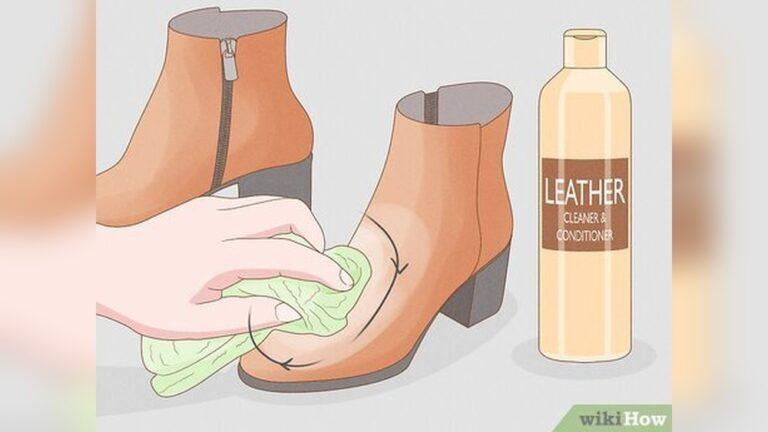Are your leather boots feeling a bit too roomy? Whether you bought them a size too big or they’ve stretched out over time, having boots that don’t fit right can be uncomfortable and frustrating.
But don’t worry—you don’t have to live with loose, sloppy boots. You can actually shrink leather boots at home with simple, effective methods that tighten them up without damaging the material. In this guide, you’ll discover easy steps to get your boots fitting snugly again, so you can enjoy both comfort and style every time you wear them.
Ready to make your leather boots fit like they were made just for you? Keep reading to learn how.
Reasons To Shrink Leather Boots
Leather boots sometimes come too big or become loose over time. Shrinking them can improve the fit and comfort. Many people want a snug fit for better support and style.
Shrinking boots can also restore their original shape after stretching. This process helps maintain the durability and look of the leather. It can save money by avoiding new purchases.
Common Fit Issues
Leather boots may feel loose or baggy after some use. This causes discomfort and blisters during walking. Boots bought online might not fit perfectly.
Sometimes, leather stretches in certain areas like the heel or toe box. This leads to slipping or rubbing against the skin. Shrinking targets these problem spots to improve the fit.
Benefits Of A Perfect Fit
Well-fitted boots provide better foot support and stability. They reduce the risk of foot pain and injuries. Proper fit enhances walking comfort and balance.
Boots that fit well look better and last longer. Shrinking helps keep the leather firm and tight. This preserves the boot’s shape and style over time.
Materials Needed
Before you start shrinking your leather boots, gather the right materials. Using proper tools ensures safe and effective shrinking. Prepare everything so the process goes smoothly and your boots stay in good shape.
Water And Heat Tools
Water is key to shrinking leather. You need a spray bottle or a clean cloth to apply water evenly. Lukewarm water works best to avoid damage.
Heat helps tighten the leather fibers. A hairdryer or a heat gun set to low is ideal. Avoid direct flames or very high heat to prevent burns or cracks.
Protective Gear
Protect your hands with gloves to avoid burns or irritation. Leather can get hot during the shrinking process.
Use old towels or rags to protect surfaces from water and heat. Keep a well-ventilated area to prevent inhaling any fumes or moisture.
Water Soaking Method
The water soaking method is a simple way to shrink leather boots. It uses water to tighten the leather fibers. This process can help boots fit better and feel more comfortable. It requires careful steps to avoid damage. Follow the guide below to learn how to do it right.
Preparing The Boots
Clean the boots gently before soaking. Remove dirt with a soft brush or cloth. Check for any damage or loose parts. Leather with cracks may get worse if soaked. Remove the laces to let water reach inside easily. Use lukewarm water, not hot or cold.
Soaking Process
Fill a basin with enough lukewarm water. Submerge the boots fully to absorb water. Let them soak for about 10 to 15 minutes. Avoid soaking too long to protect leather quality. After soaking, press the boots gently to remove excess water. Do not wring or twist the leather.
Drying Techniques
Dry boots slowly at room temperature. Avoid direct sunlight or heat sources like radiators. Stuff the boots with newspaper or cloth to keep shape. Change the stuffing if it becomes wet. Let boots dry for 24 to 48 hours until fully dry. Check fit and repeat if needed, but do not overdo it.
Heat Application Method
The heat application method uses warmth to shrink leather boots safely. Leather fibers tighten when exposed to heat, causing the boots to shrink. This method works best with gentle, controlled heat to avoid damage. Below are some easy ways to apply heat at home.
Using A Hairdryer
Hold a hairdryer about six inches from the boot surface.
Move the dryer evenly across the leather to avoid hot spots.
Heat the leather until it feels warm but not too hot to touch.
Wear thick socks and put the boots on while they are warm.
Walk around to help the leather mold to your feet.
Repeat if needed, but do not overheat the leather.
Sun Drying Tips
Place boots in direct sunlight for 30 to 60 minutes.
Check the boots regularly to avoid overheating or discoloration.
Turn the boots occasionally for even exposure to sunlight.
Wear the boots with thick socks after sun drying for a better fit.
Limit sun exposure to prevent leather from drying out too much.
Avoiding Damage
Never use very high heat or open flames on leather boots.
Test heat on a small hidden area before full application.
Keep leather moisturized after shrinking to prevent cracking.
Do not soak boots completely in water before heating.
Use gentle heat and short sessions to protect the leather.
Targeted Shrinking Techniques
Shrinking leather boots evenly can be tricky. Targeted shrinking techniques help adjust specific parts without harming the whole boot. These methods focus on problem areas that usually feel loose or baggy. Using water and heat carefully tightens the leather fibers where needed most.
Shrinking Around The Calf
The calf area often feels loose and needs tightening. Lightly spray warm water on the inside and outside of this section. Wear thick socks and put the boots on immediately. Walk around to stretch and mold the leather to your leg shape.
Use a hairdryer on low heat to dry the calf area slowly. Keep the dryer moving to avoid overheating. Repeat the process until the desired snug fit appears. Avoid soaking the leather, as too much water can cause damage.
Focusing On Toe And Heel Areas
Toes and heels are common spots for extra space. Apply a small amount of water only to these parts. Use a cloth to spread water evenly without soaking. Wear the boots with thick socks and walk to shape the leather.
Dry these areas gently with a hairdryer to shrink the leather fibers. Add padding or insoles for extra tightness if needed. This technique keeps the boots comfortable while reducing looseness in key areas.

Credit: www.reddit.com
Wearing Boots For A Custom Fit
Wearing boots for a custom fit helps shape the leather to your feet. This process makes boots tighter and more comfortable. Leather softens and molds as you wear it. This natural adjustment can reduce extra space inside your boots. Small changes in fit improve comfort and support. You control the fit by how you wear and move in the boots.
Wearing With Thick Socks
Put on thick socks before wearing your boots. Thick socks fill the extra space inside boots. They create pressure on the leather. This pressure helps the leather shrink slightly. Thick socks protect your feet while the boots adjust. Wear boots with thick socks around the house for short periods. Gradually increase the wearing time to avoid discomfort.
Walking And Flexing
Walk around in your boots to help them shrink. Moving your feet flexes the leather fibers. This flexing causes the leather to tighten and shape to your feet. Take slow, deliberate steps for better control. Bend your feet and toes inside the boots often. Regular walking and flexing speed up the custom fit process. Avoid standing still for long periods to encourage molding.
Professional Shrinking Options
Professional shrinking options offer precise results for leather boots. Skilled experts use special tools and methods. This ensures your boots shrink evenly and keep their shape. Professionals can handle delicate leather without damage. Their knowledge helps avoid common home shrinking mistakes. Seeking expert help saves time and effort.
When To See A Cobbler
Visit a cobbler if your boots are too loose. If home methods do not work, ask for help. Cobblers can fix size issues that DIY methods cause. If boots are expensive or sentimental, trust a pro. When you want a perfect fit without risk, see a cobbler.
Services Offered
Cobblers offer several shrinking services tailored to leather boots. They use controlled heat and moisture to shrink leather safely. Some cobblers use steam machines designed for leather care. They can reshape boots while shrinking to maintain comfort. Many also provide cleaning and conditioning after shrinking. This keeps leather soft and durable. Professional services ensure your boots fit better and last longer.

Credit: www.vintageleather.com.au
Precautions And Dos And Don’ts
Taking care during the shrinking process protects your leather boots. Small mistakes can cause permanent damage. Knowing the right steps helps keep the boots in good condition. Follow these precautions and dos and don’ts for best results.
Avoiding Over-shrinking
Shrinking too much can make boots tight and uncomfortable. Stop after a small shrink to test the fit. Use mild heat and moisture to control the process. Avoid using high heat or boiling water. Leather can crack or warp with too much shrinking. Always shrink boots slowly and in stages.
Leather Care After Shrinking
Leather needs care after shrinking to stay soft and strong. Apply a good leather conditioner to restore moisture. Let the boots dry naturally away from direct sunlight. Avoid using harsh chemicals or cleaners. Store boots in a cool, dry place to keep their shape. Regular care keeps leather boots lasting longer after shrinking.
Common Questions
Shrinking leather boots raises many questions for wearers. Understanding what to expect helps protect your boots. Below are common questions about shrinking leather boots.
How Much Can Boots Shrink?
Leather boots can shrink up to half a size safely. Trying to shrink them more may cause damage. The amount depends on the leather type and treatment. Always aim for small adjustments to avoid problems.
Do Leather Boots Shrink Naturally?
Leather boots can shrink slightly over time with exposure to moisture and heat. Natural shrinking is slow and minor. Regular wear and weather changes cause this effect. But natural shrinking alone rarely makes boots much smaller.
Can Shrinking Damage Boots?
Yes, improper shrinking can damage leather boots. Using too much water or heat can dry out the leather. This causes cracks or stiffness. Controlled shrinking with gentle methods helps keep boots safe and intact.

Credit: www.youtube.com
Frequently Asked Questions
Can You Make Leather Boots Shrink?
Yes, you can shrink leather boots by wetting them lightly and applying gentle heat. Wear them while drying to tighten fit. Avoid over-soaking or high heat to prevent damage. Shrinking usually reduces size by about half a size safely.
How Many Sizes Can You Shrink Leather Boots?
You can typically shrink leather boots up to half a size safely. Shrinking more risks damaging the leather.
How Do I Make My Boots Tighter?
Tighten boots by wearing thick socks and lacing them firmly. Use insoles or heel grips for a snug fit. Apply gentle heat after lightly dampening leather to shrink fibers carefully. Avoid over-tightening to prevent damage.
What To Do If Leather Boots Are Too Big?
Fill the boots with thick socks or insoles to reduce space. Use heel grips or tongue pads for a snug fit. Consider professional resizing or shrinking with controlled water and heat methods carefully.
Conclusion
Shrinking leather boots takes patience and care. Use water and gentle heat to tighten fibers. Avoid soaking them too long to prevent damage. Wear thick socks while boots dry for a better fit. Test methods on a small area first.
Proper shrinking improves comfort and extends boot life. Follow these simple steps for boots that fit just right. Keep your boots dry and clean after shrinking. With care, your leather boots will feel snug and last longer.

Madison Clark is a footwear expert and the voice behind MyStyleGrid.com. She specializes in honest shoe reviews, style tips, and practical guides to help readers find the perfect pair for any occasion. With years of experience in blogging and content creation, Madison makes footwear knowledge simple, stylish, and easy to follow.







